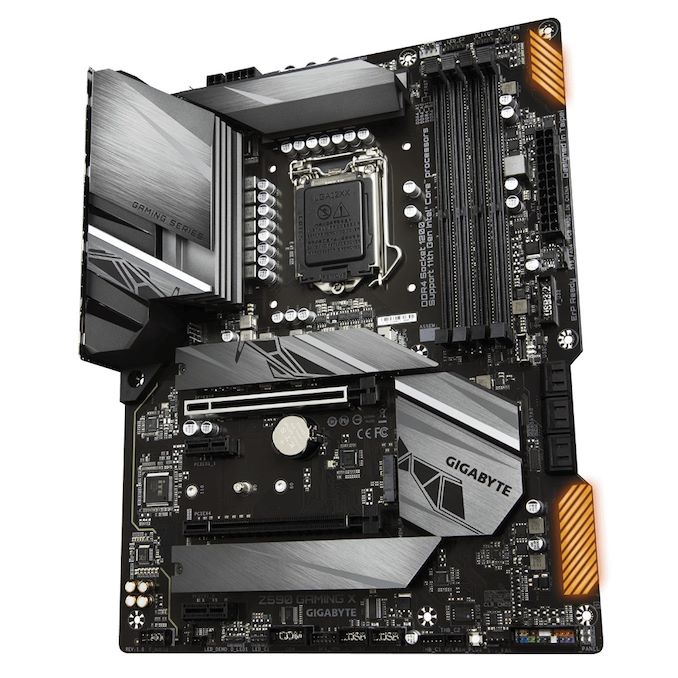The Intel Z590 Motherboard Overview: 50+ Motherboards Detailed
by Gavin Bonshor on January 19, 2021 10:15 AM ESTGIGABYTE Z590 Gaming X
GIGABYTE's Aorus gaming series targets the mid-range. Still, for entry-level users looking for gaming-specific features, there's the Z590 Gaming X. Despite sitting towards the bottom of GIGABYTE's stack of gaming models, the Z590 Gaming X is advertised with a direct 12+1 phase power delivery, three M.2 slots, as well as Intel's 2.5 GbE controller.
The GIGABYTE Z590 Gaming X follows a modern black and brushed steel design, with LED's built onto the board in the top right and bottom right corners. The rear panel cover, M.2, and chipset heatsinks include a black contrasting design on a silver background, with an all-black PCB.
Towards the board's center and bottom are two full-length PCIe slots, with the top slot operating at PCIe 4.0 x16, and the bottom slot locked down to PCIe 3.0 x4, with two PCIe 3.0 x1 slots. For storage, the Z590 Gaming X includes three slots in total. The top M.2 slot operates a PCIe 4.0 x4, while the central and bottom M.2 slots have support for PCIe 3.0 x4 and SATA drives. The board also includes six SATA ports with support for RAID 0, 1, 5, and 10 arrays located in an X-shaped cutout. In the top-right hand corner is four memory slots with users able to install up to 128 GB, but GIGABYTE hasn't at this time released its QVL list, so for now, memory is only listed at DDR4-3200.
The rear panel includes one USB 3.2 G2 Type-C, one USB 3.2 G2 Type-A, five USB 3.2 G1 Type-A, and two USB 2.0 ports. Powering the single RJ45 port is a Realtek RTL8125 2.5 GbE controller, with an unspecified Realtek HD audio codec driving the board's six 3.5 mm audio jacks. Finishing off the rear panel is a DisplayPort video output and PS/2 keyboard and mouse combo port.
At the time of writing, GIGABYTE hasn't shared any details on its Z590 models' pricing.












88 Comments
View All Comments
Oxford Guy - Tuesday, January 19, 2021 - link
You’ll never be able to block all the spyware with a firewall. Windows is just one component of it. Don’t forget things like stealth CPUs that are built into the CPU, like the little friend on Lando’s shoulder. Etc.lmcd - Tuesday, January 19, 2021 - link
What, the tinfoil hat isn't enough anymore? The "spyware" is just as present on any Windows era.If you want to disable built in telemetry, pay for pro and disable it in the registry. It's not hard if you're really that into privacy.
Spunjji - Wednesday, January 20, 2021 - link
@lmcd - but that would require *effort* - why waste that effort on customising a modern OS, when he could expend more effort cobbling together a barely-working platform on a 12-year-old one? 😂Makaveli - Wednesday, January 20, 2021 - link
lol all I saw in my head reading those post are "old man yells at clouds"Oxford Guy - Friday, January 22, 2021 - link
That’s due to the fact that the old man has just as much chance of getting the spyware out of Windows and CPUs (and the rest) as you lot have a chance of saying something relevant.Oxford Guy - Friday, January 22, 2021 - link
Call us when the shuttle lands, Pauline.Slash3 - Tuesday, January 19, 2021 - link
Z590 only provides six native SATA ports.ASRock's Z590 Taichi has eight ports, with two via an ASMedia ASM1061 controller.
Silver5urfer - Wednesday, January 20, 2021 - link
Got it thanks. I suppose that's how the EVGA Dark got it's 8 SATA ports too.weilin - Thursday, April 29, 2021 - link
Z590, if i remember correctly... has 30 HSIO lanes total:6 of which are dedicated to USB (and can be ganged in pairs for 20Gb/s ports)
4 more that is either USB 10Gb/s or 5Gb/s or PCIe.
2 of them which can be Ethernet or PCIe,
2 of them which can be SATA, Ethernet, or PCIe.
6 of them which can be SATA or PCIe.
10 dedicated PCIe
So everything all together means theoretically maximum of:
4 LAN ports
8 SATA ports
10 USB ports
24 PCIe ports
It's up to motherboard manufacturers to configure them as they see fit. It seems like the popular choice is to maximize USB, leave SATA at 6 and put the rest on PCIe ports (take 1 or 2 away for Ethernet, and 4 away for Thunderbolt if present).
weilin - Thursday, April 29, 2021 - link
If anyone's interested in see the doc:https://ark.intel.com/content/www/us/en/ark/produc...
On to left its under "Technical Documentation" -> "Intel® 500 Series Chipset Family Platform Controller Hub Datasheet, Volume 1 of 2" -> bottom of page 18